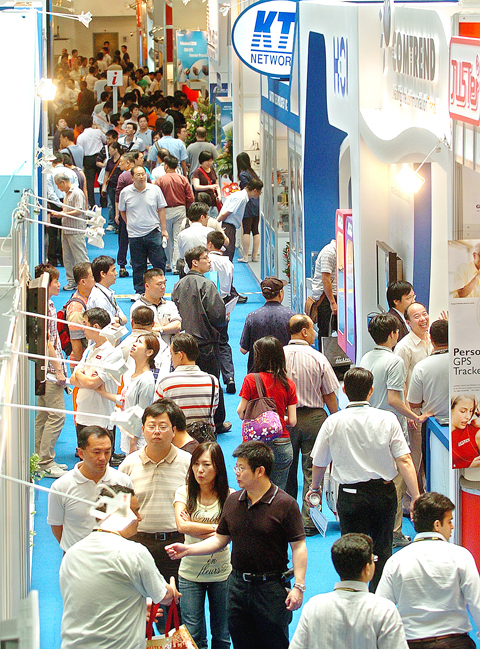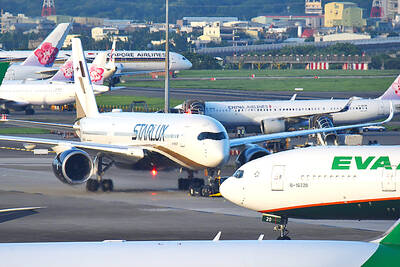Computex, the second-biggest computer trade show in the world, attracted a record number of buyers this year, with the fastest growing percentage coming from emerging markets such as China and India because the economic slump seemed to have a less severe impact on their economies, a co-organizer of the event said yesterday.
This year, the number of overseas buyers climbed 1 percent compared with last year to 34,900, the highest since the show began three decades ago, initial statistics from government-financed Taiwan External Trade Development Council (TAITRA, 外貿協會) showed. But the number of local buyers leapt by more than 10 percent to 84,000 from a year ago.
“Messages from Computex exhibitors indicate the economic recession did not have a serious impact on customers’ billing during Computex. Instead, the billing is better than expected,” said Walter Yeh (葉明水), executive vice president of TAITRA.

PHOTO: FANG PIN-CHAO, TAIPEI TIMES
“We felt relieved that the A(H1N1) flu epidemic did not prevent global buyers from coming to Taiwan,” Yeh said.
The show is expected to help local exhibitors secure US$20 billion in orders, unchanged from last year, because the latest gadgets such as next-generation netbooks have a strong appeal to overseas purchasers from big companies such as Germany’s Siemens, Yeh said.
“The new orders will help local companies offset the impact from the economic downturn and also signals a positive sign for the business outlook for the rest of the year,” he said.
Local companies also secured more than US$100 million in orders through face-to-face talks arranged with global buyers, TAITRA said. Those deals could bring more orders in the subsequent year, bringing total orders to US$700 million, more than doubling from NT$300 million last year, the council said.
The number of of buyers from China climbed by the fastest rate, 34 percent, to 1,419 excluding those from Hong Kong, compared with last year, Yeh said. He added that improving cross-strait trade ties and the government’s relaxed cross-strait polices such as direct flights were the main reasons for the increase.
Buyers from the US rose by just 0.7 percent to 5,017 during the first four days compared with last year, bucking the downtrend of the US’ economy, TAITRA said. The top five overseas buyers were from the US, Japan, Hong Kong, China and South Korea.
Netbooks, portable navigation devices, smartphones, mobile Internet devices and electronic readers were at the top Computex buyers’ shopping list, TAITRA said.

RECYCLE: Taiwan would aid manufacturers in refining rare earths from discarded appliances, which would fit the nation’s circular economy goals, minister Kung said Taiwan would work with the US and Japan on a proposed cooperation initiative in response to Beijing’s newly announced rare earth export curbs, Minister of Economic Affairs Kung Ming-hsin (龔明鑫) said yesterday. China last week announced new restrictions requiring companies to obtain export licenses if their products contain more than 0.1 percent of Chinese-origin rare earths by value. US Secretary of the Treasury Scott Bessent on Wednesday responded by saying that Beijing was “unreliable” in its rare earths exports, adding that the US would “neither be commanded, nor controlled” by China, several media outlets reported. Japanese Minister of Finance Katsunobu Kato yesterday also

China Airlines Ltd (CAL, 中華航空) said it expects peak season effects in the fourth quarter to continue to boost demand for passenger flights and cargo services, after reporting its second-highest-ever September sales on Monday. The carrier said it posted NT$15.88 billion (US$517 million) in consolidated sales last month, trailing only September last year’s NT$16.01 billion. Last month, CAL generated NT$8.77 billion from its passenger flights and NT$5.37 billion from cargo services, it said. In the first nine months of this year, the carrier posted NT$154.93 billion in cumulative sales, up 2.62 percent from a year earlier, marking the second-highest level for the January-September

‘DRAMATIC AND POSITIVE’: AI growth would be better than it previously forecast and would stay robust even if the Chinese market became inaccessible for customers, it said Taiwan Semiconductor Manufacturing Co (TSMC, 台積電) yesterday raised its full-year revenue growth outlook after posting record profit for last quarter, despite growing market concern about an artificial intelligence (AI) bubble. The company said it expects revenue to expand about 35 percent year-on-year, driven mainly by faster-than-expected demand for leading-edge chips for AI applications. The world’s biggest contract chipmaker in July projected that revenue this year would expand about 30 percent in US dollar terms. The company also slightly hiked its capital expenditure for this year to US$40 billion to US$42 billion, compared with US$38 billion to US$42 billion it set previously. “AI demand actually

Jensen Huang (黃仁勳), founder and CEO of US-based artificial intelligence chip designer Nvidia Corp and Taiwan Semiconductor Manufacturing Co (TSMC, 台積電) on Friday celebrated the first Nvidia Blackwell wafer produced on US soil. Huang visited TSMC’s advanced wafer fab in the US state of Arizona and joined the Taiwanese chipmaker’s executives to witness the efforts to “build the infrastructure that powers the world’s AI factories, right here in America,” Nvidia said in a statement. At the event, Huang joined Y.L. Wang (王英郎), vice president of operations at TSMC, in signing their names on the Blackwell wafer to